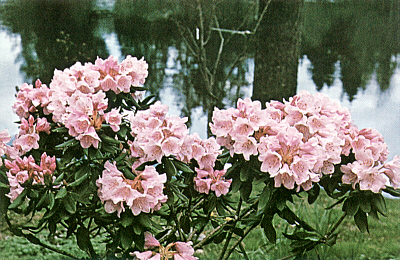QBARS - v25n3 Rhododendron pseudochrysanthum
Rhododendron pseudochrysanthum
Carl H. Petteplace, M.D., Eugene, Oregon

|
|---|
R. pseudochrysanthum , Exbury form Photo by Carl H. Phetteplace, M.D. |
In May of 1960 while walking about Exbury Gardens with Major Peter Barber my attention was especially attracted by a plant, then about four feet tall, very compact, and covered with pale pink and white flowers. On inquiry I was told that this was R. pseudochrysanthum and it was Major Barber's opinion that once this species was well known it would be as highly regarded and sought after as R. yakushimanum . Later I received some cuttings from Major Barber of this Exbury plant which rooted and grafted readily, and now have a plant in my garden about 30 inches tall.
At first I knew nothing about growing it and planted it in almost full shade. It became rather leggy. After planting it in full sun, however, I found it much happier and it soon became a very densely compact plant which covers itself every year with pink flowers, five to nine in the truss, spotted in the throat and soon fading to white.
Perhaps the foliage is one of the most interesting features of this species. The new leaves appear as if dusted with a white powder on the upper surface, although there is little gross indumentum. The tomentum under the lens is seen to consist of a mat of white hairs. They persist well into the winter season when this feature is eventually lost but these stiff, sturdy, pointed leaves persist on the plant for three or four years, adding to its compact appearance. It has so far seemed too tough for weevils to nibble on. I feel sure it would be hardy to temperatures well below 0 degrees F. It is very sturdy in appearance and should never become of great size.
It has no resemblance whatever to R. chrysanthum as the name might suggest but it is in the Barbatum Series, while R. chrysanthum is in the Ponticum Series. An excellent description and history of this species, which was first collected for cultivation by E. H. Wilson on Taiwan, is to be found on p. 102 of the 1971 Rhododendron and Camellia Yearbook of the R. H. S., written by Edmund de Rothschild. It is one of my favorite garden species. Like R. yakushimanum , I would be reluctant to tinker with pollen on it as my imagination cannot visualize an improvement on this pleasing blend of features which have been given it by Mother Nature.

